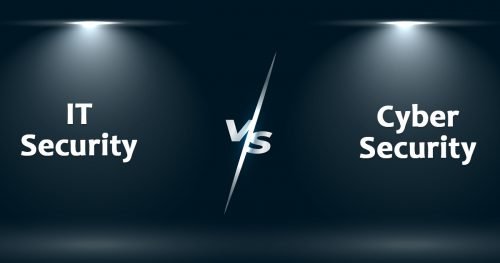IT Security vs Cyber Security – Everything You Should Know

It may seem okay to use information technology IT security and cyber security interchangeably. Both terms refer to related, complementary practices that counter malicious acts and data breaches. They also deal with the physical security of information, assess the value of the data they protect, and focus on an organization’s sensitive data.
Despite these similarities, cyber security and IT security are different. To help you correct your understanding of each, here are the main differences between both terms.
IT Security vs Cyber Security: Different Definitions
The first difference between both terms is their definition.
So, what is cybersecurity? According to CISCO, this term refers to the practice of preventing digital attacks on systems, networks, and programs. By implementing cyber security measures, organizations can prevent access to sensitive information. Therefore, information cannot be changed or destroyed.
As for IT security, CISCO defines it as a group of strategies which prevent unauthorized access to organizational assets. Moreover, IT security ensures the integrity and confidentiality of sensitive information.
IT Security vs Cybersecurity: Scope
As you probably guessed from their definitions, both terms cover different scopes.
IT security encompasses both electronic and physical data. Therefore, in addition to how electronic data is handled, it extends to how files are printed and physically stored.
As for cybersecurity, it is limited to how electronic data is transmitted online. That is why a cybersecurity plan outlines policies that prevent online hacking and other similar threats.
IT Security vs Cybersecurity: Approach
By implementing IT security measures, organizations can ensure the confidentiality, availability, and integrity of company information. This type of security also extends to the collection, storage, sharing, and processing of data – both virtually and physically.
Some of the measures used to achieve this include:
- Network Security – This type of IT security aims to prevent unauthorized or malicious users from gaining access to a network. It further prevents hackers from affecting users’ ability to access or use a network.
- Internet Security – With this measure, organizations can protect information sent and received in browsers as well as web-based applications.
- Endpoint Security – Endpoint security is carried out at the device level to prevent access to malicious networks that could threaten an organization.
- Cloud Security – Measures under this type of IT security secure the use of software-as-a-service applications and the public cloud. This is essential since traditional security stack does not protect apps, data, and identities in the cloud.
- Application Security – Application security ensures they are not vulnerable to attacks. This is usually done during the time of their creation.
As for cybersecurity, the approach entails protecting sensitive data against access through online channels. Therefore, professionals analyze risks and a plan for risk management accordingly.
Like IT security, cyber security uses the methods above. However, since the scope of both is different, cybersecurity only deals with the online aspect. Therefore, these methods are solely used for preventing cyber-attacks such as phishing, ransomware, malware, and social engineering.
IT Security vs Cyber Security: Implementation
Since IT security extends beyond cyberspace, it covers physical access to different departments in an organization. It further determines roles and authorizations related to opening and modifying files. An IT security plan will also detail how to collect and handle data, be it in electronic or physical formats.
On the other hand, cybersecurity is more focused on preventative and risk management measures. Through techniques such as password protection and data encryption, organizations can keep sensitive data safe even when online.
IT Security vs Cybersecurity: Career Responsibilities
If you are interested in a role related to IT security, some of the responsibilities assigned to you include:
- Assessing the bigger picture of your organization’s security landscape
- Strategizing how to protect data from different threats
- Monitoring systems for unauthorized access, modification or disruption
- Planning for recovering after a breach
On the other hand, during a cybersecurity career, you may need to:
- Focus on online threats and how to counter them
- Think like a hacker to prevent their access into your organization’s sensitive data
- Develop an understanding of malicious software and how to prevent its effects
- Come up with techniques to act as the first line of defense
To truly make your career in any of these, however, earn a certification. Not only would this credential boost your resume, but it will also vouch for your experience and expertise as an IT security or cybersecurity professional.
Bottom Line
IT security and cyber security complement one another but are not the same. Regardless, both are excellent career choices if you have the necessary skills and expertise.
If you need more help, our Training Advisors will gladly guide you on which of these will help you best meet your career goals. So, do not hesitate to get in touch for effective guidance towards your future.




